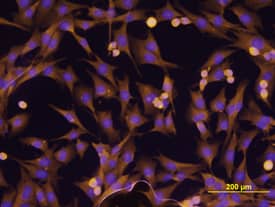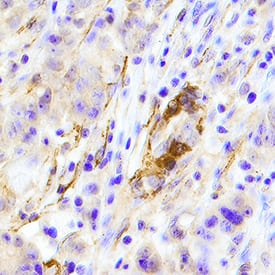Human ErbB2/Her2 Antibody
R&D Systems, part of Bio-Techne | Catalog # MAB1129


Conjugate
Catalog #
Key Product Details
Species Reactivity
Validated:
Human
Cited:
Human, Mouse
Applications
Validated:
CyTOF-ready, ELISA Capture (Matched Antibody Pair), Flow Cytometry, Immunocytochemistry, Immunohistochemistry, Western Blot
Cited:
Flow Cytometry, Immunocytochemistry, Immunoprecipitation, Luminex Development, Western Blot
Label
Unconjugated
Antibody Source
Monoclonal Mouse IgG2B Clone # 191924
Product Specifications
Immunogen
Mouse myeloma cell line NS0-derived recombinant human ErbB2/Her2
Thr23-Thr652
Accession # P04626
Thr23-Thr652
Accession # P04626
Specificity
Detects human ErbB2/Her2 in ELISAs and Western blots. In ELISAs and Western blots, this antibody does not cross-react with recombinant human (rh) EGF R, rhErbB3, or rhErbB4.
Clonality
Monoclonal
Host
Mouse
Isotype
IgG2B
Scientific Data Images for Human ErbB2/Her2 Antibody
Detection of ErbB2/Her2 in MCF‑7 Human Cell Line by Flow Cytometry.
MCF-7 human breast cancer cell line was stained with Mouse Anti-Human ErbB2/Her2 Monoclonal Antibody (Catalog # MAB1129, filled histogram) or isotype control antibody (Catalog # MAB0041, open histogram), followed by Phycoerythrin-conjugated Anti-Mouse IgG Secondary Antibody (Catalog # F0102B). View our protocol for Staining Membrane-associated Proteins.Detection of ErbB2/Her2 in MDA-MB-453 Human Cell Line by Flow Cytometry.
MDA-MB-453 human breast cancer cell line was stained with Mouse Anti-Human ErbB2/Her2 Monoclonal Antibody (Catalog # MAB1129, filled histogram) or isotype control antibody (Catalog # MAB0041, open histogram), followed by Phycoerythrin-conjugated Anti-Mouse IgG Secondary Antibody (Catalog # F0102B). View our protocol for Staining Membrane-associated Proteins.ErbB2/Her2 in MDA‑MB‑231 Human Cell Line.
ErbB2/Her2 was detected in immersion fixed MDA-MB-231 human breast cancer cell line using Mouse Anti-Human ErbB2/Her2 Monoclonal Antibody (Catalog # MAB1129) at 10 µg/mL for 3 hours at room temperature. Cells were stained using the NorthernLights™ 557-conjugated Anti-Mouse IgG Secondary Antibody (yellow; Catalog # NL007) and counterstained with DAPI (blue). View our protocol for Fluorescent ICC Staining of Cells on Coverslips.Applications for Human ErbB2/Her2 Antibody
Application
Recommended Usage
CyTOF-ready
Ready to be labeled using established conjugation methods. No BSA or other carrier proteins that could interfere with conjugation.
Flow Cytometry
0.25 µg/106 cells
Sample: MCF‑7 human breast cancer cell line and MDA-MB-453 human breast cancer cell line
Sample: MCF‑7 human breast cancer cell line and MDA-MB-453 human breast cancer cell line
Immunocytochemistry
8-25 µg/mL
Sample: Immersion fixed MDA-MB-231 human breast cancer cell line
Sample: Immersion fixed MDA-MB-231 human breast cancer cell line
Immunohistochemistry
8-25 µg/mL
Sample: Immersion fixed paraffin-embedded sections of human stomach and human breast cancer
Sample: Immersion fixed paraffin-embedded sections of human stomach and human breast cancer
Western Blot
1 µg/mL
Sample: Recombinant Human ErbB2/Her2 Fc Chimera (Catalog # 1129-ER)
under non-reducing conditions only
Sample: Recombinant Human ErbB2/Her2 Fc Chimera (Catalog # 1129-ER)
under non-reducing conditions only
Human ErbB2/Her2 Sandwich Immunoassay
Please Note: Optimal dilutions of this antibody should be experimentally determined.
Reviewed Applications
Read 2 reviews rated 5 using MAB1129 in the following applications:
Formulation, Preparation, and Storage
Purification
Protein A or G purified from hybridoma culture supernatant
Reconstitution
Reconstitute at 0.5 mg/mL in sterile PBS. For liquid material, refer to CoA for concentration.
Formulation
Lyophilized from a 0.2 μm filtered solution in PBS with Trehalose. *Small pack size (SP) is supplied either lyophilized or as a 0.2 µm filtered solution in PBS.
Shipping
Lyophilized product is shipped at ambient temperature. Liquid small pack size (-SP) is shipped with polar packs. Upon receipt, store immediately at the temperature recommended below.
Stability & Storage
Use a manual defrost freezer and avoid repeated freeze-thaw cycles.
- 12 months from date of receipt, -20 to -70 °C as supplied.
- 1 month, 2 to 8 °C under sterile conditions after reconstitution.
- 6 months, -20 to -70 °C under sterile conditions after reconstitution.
Background: ErbB2/Her2
References
- Coussens, L. et. al. (1985) Science 230:1132.
- Yamamoto, T. et. al. (1986) Nature 319:230.
- Kanai, Y. et. al. (1995) Biochem. Biophys. Res. Commun. 208:1067.
- Codony-Servat, J. et. al. (1999) Cancer Res. 59:1196.
- Carraway, K.L. 3rd et. al. (1994) J. Biol. Chem. 269:14303.
- Emkey, R. and C.R. Kahn (1997) J. Biol. Chem. 272:31172.
- Schaefer, G. et. al. (1999) J. Biol. Chem. 274:859.
- Schlessinger, J. (2000) Cell 103:211.
- Hellyer, N.J. et. al. (2001) J. Biol. Chem. 276:42153.
- Daly, R.J. (1999) Growth Factors 16:255.
Long Name
Receptor Tyrosine Protein Kinase ErbB2
Alternate Names
CD340, HER2, Neu Oncogene, NGL, TKR1
Gene Symbol
ERBB2
UniProt
Additional ErbB2/Her2 Products
Product Documents for Human ErbB2/Her2 Antibody
Product Specific Notices for Human ErbB2/Her2 Antibody
For research use only
